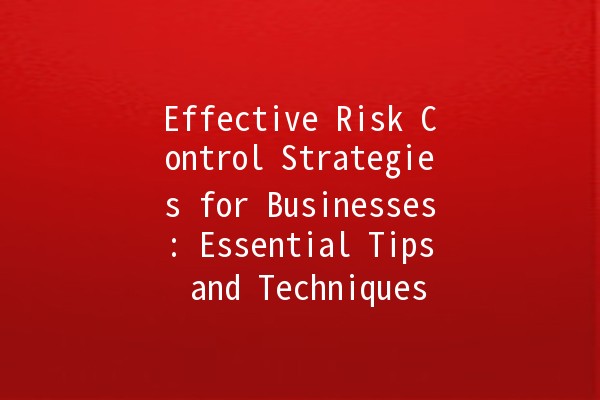




Managing risk is an essential component of running a successful business. In a rapidly changing environment, understanding how to identify, assess, and mitigate risks can make all the difference between thriving or merely surviving. This article explores effective risk control strategies and practical tips that you can apply to enhance your business’s stability and growth.

Risk control refers to the process of identifying potential threats to a business and implementing strategies to minimize the impact of these risks. This could involve anything from financial risks, operational hazards, legal complications, to reputational damage. A proactive approach to risk management allows businesses to sustain their operations and maintain customer trust.
Identification of Risks: Understanding and recognizing potential risks to your business.
Assessment of Risks: Evaluating the likelihood and potential impact of identified risks.
Mitigation Strategies: Implementing controls to reduce the severity or likelihood of risks.
Monitoring and Review: Regularly reviewing risk management processes to ensure effectiveness.
Description: Conducting regular risk assessments, also known as risk evaluations, keeps you aware of the potential threats to your business.
Application Example: A retail business might conduct quarterly assessments to identify emerging threats such as supply chain disruptions or seasonal sales fluctuations. By systematically evaluating these risks, they can adjust strategies in time to mitigate negative impacts.
Description: Diversifying investments is a fundamental strategy for spreading risk. Instead of putting all your resources into one area, consider multiple investments.
Application Example: An investment firm may diversify its portfolio by investing in various sectors such as technology, healthcare, and real estate. By doing so, if one sector underperforms, the firm won’t suffer catastrophic losses due to its varied investment base.
Description: Insurance serves as a safety net against unexpected events that can jeopardize your business operations.
Application Example: A small business owner may choose to invest in a comprehensive insurance policy that covers property damage, liability claims, and business interruption. Having such coverage can significantly cushion the financial blow from unforeseen events.
Description: Creating clear, documented procedures helps streamline operations and minimizes potential errors, which can lead to risks.
Application Example: A manufacturing company might implement strict protocols for machinery operation and maintenance. This not only enhances safety but also reduces risks associated with equipment failure due to lack of maintenance.
Description: Regular training can equip employees with the necessary knowledge and skills to identify and respond to risks effectively.
Application Example: A customer service department could host quarterly training sessions that focus on data protection and cyber safety, which are increasingly important in today’s digital marketplace. Employees learn how to identify phishing attempts, reducing the risk of data breaches.
Businesses commonly face financial risks (such as market fluctuations), operational risks (like supply chain interruptions), compliance risks (failure to comply with regulations), strategic risks (wrong market decisions), and reputational risks (loss of customer trust due to negative publicity). Each type necessitates tailored risk mitigation strategies to prevent detrimental impacts.
It is advisable for businesses to conduct risk assessments at least annually; however, more frequent assessments (quarterly or biannually) are beneficial, especially in industries subject to rapid change. Regular evaluations ensure that new risks are identified and that existing controls remain effective.
Absolutely! Small businesses can effectively manage risks by prioritizing risks based on their potential impact and focusing on affordable strategies. Techniques like collaborative networking, leveraging technology, and utilizing comprehensive yet costeffective insurance solutions can significantly reduce risks.
Technology plays a crucial role in risk management. Software tools dedicated to risk assessment and mitigation can simplify the risk evaluation process and provide analytics for informed decisionmaking. Technologies like data analytics, AI, and cybersecurity solutions enable businesses to proactively manage risks and enhance their security posture.
A strong company culture that prioritizes risk awareness and accountability significantly enhances risk management efforts. When employees understand the importance of risk control and feel empowered to report risks or suggest improvements, organizations can respond agilely to potential threats.
Measuring the effectiveness of risk management strategies involves tracking performance metrics such as incident reports, financial losses due to risks, compliance rates, and employee training completion rates. Regularly evaluating these metrics against set benchmarks allows businesses to refine their risk management processes continually.
Understanding and implementing effective risk control strategies is crucial for any business aiming to thrive in today’s dynamic marketplace. By integrating these effective techniques into your operational framework, you can significantly reduce potential threats and enhance your organization's resilience against unexpected challenges. Regular assessments, diversification, robust insurance, clear procedures, and continuous education are not just best practices; they are essential components of a sustainable business strategy.
By prioritizing risk control, you not only safeguard your business's future but also foster an environment where innovation can flourish, and employees can work confidently knowing that the organization is wellprepared for whatever challenges may arise. Don't leave your business's fate to chance; take control of the risks and pave the way for success.